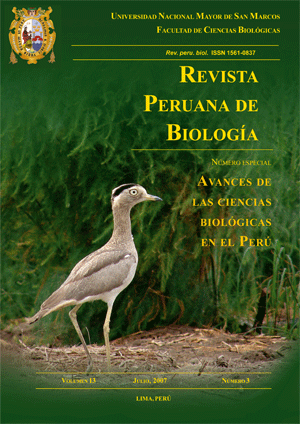Isolation and some properties of Be1 toxin from the venom of Brachistosternus ehrenbergii (Gervais, 1841) (Scorpiones:Bothriuridae)
DOI:
https://doi.org/10.15381/rpb.v13i3.2349Keywords:
toxin, scorpion venom, Brachistosternus ehrenbergiiAbstract
By means of cationic exchange chromatography on CM-Sephadex C-25 column (16 x 1,1 cm) with ammonium acetate buffer 0,05 M at pH 7, from Brachistosternus ehrenbergii scorpion venom was isolated a protein with toxic activity on mice. In this system the toxin was ligated to gel and was eluated with buffer and NaCl 0,6M. The toxin denominated Be1 and it characterizes to be a basic protein that constitute 8,1% of venom total protein. Toxin purity was evaluated by electrophoresis in natives conditions, according to Reisfeld-method, and denaturants conditions by the Schägger-and-von Jagow-method, the toxin is a single chain polypeptide of 6,3 kDa has been determined. The inoculation of 60 μg toxin on albino mice, intraperitoneal way, produces some local signals as salival hipersecretion followed by respiratory affection, drags hind feet and finally 2 hours after, death. Intramuscular way (7,6 μg) Be1 produces temporal paralysis of the inoculated limb. The toxin has neither phospholipase, nor protease, nor acetylcholinesterase nor acetylcholinesterase inhibitor activity.Downloads
Downloads
Published
Issue
Section
License
Copyright (c) 2006 Catherina Ramos, Enrique Escobar

This work is licensed under a Creative Commons Attribution-NonCommercial-ShareAlike 4.0 International License.
AUTHORS RETAIN THEIR RIGHTS:
a. Authors retain their trade mark rights and patent, and also on any process or procedure described in the article.
b. Authors retain their right to share, copy, distribute, perform and publicly communicate their article (eg, to place their article in an institutional repository or publish it in a book), with an acknowledgment of its initial publication in the Revista Peruana de Biologia.
c. Authors retain theirs right to make a subsequent publication of their work, to use the article or any part thereof (eg a compilation of his papers, lecture notes, thesis, or a book), always indicating its initial publication in the Revista Peruana de Biologia (the originator of the work, journal, volume, number and date).


















